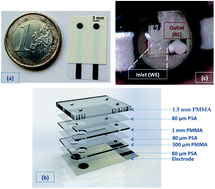An integrated sensing and wireless communications platform for sensing sodium in sweat†
Abstract
The ability to non-invasively monitor sodium levels in sweat is of significant importance. Sodium is one of the preferred markers to diagnose and track the progression of cystic fibrosis, and knowledge of sodium levels could potentially enable personalised hydration strategies to be implemented for athletes or people working under severe environmental conditions. Herein we present a novel approach for the realisation of disposable potentiometric strips that allow for real-time monitoring of sodium in sweat. Our platform consists of a Solid-Contact Ion-Selective Electrode (SC-ISE) for Na+ detection and of a liquid-junction-free Reference Electrode (RE), combined together on a dual screen-printed substrate. Different poly-3,4-ethylenedioxythiophene (PEDOT) based films were tested as solid-contact, showing a significant impact on sensor characteristics such as sensitivity (i.e. differing from sub-Nernstian to Nernstian), dynamic range (i.e. 10−5 to 10−2.5 or 10−5 to 10−1aNa+), and especially within-batch reproducibility. The SC-ISE/RE combination was integrated into a microfluidic chip that was tested and optimised via on-bench trials. The Potentiometric Microfluidic Chip (PotMicroChip) was then connected to a wireless electronic platform to realise a wearable device whose performance was assessed during real-time stationary cycling sessions.

- This article is part of the themed collection: Microfluidics Research 2015-2016

 Please wait while we load your content...
Please wait while we load your content...